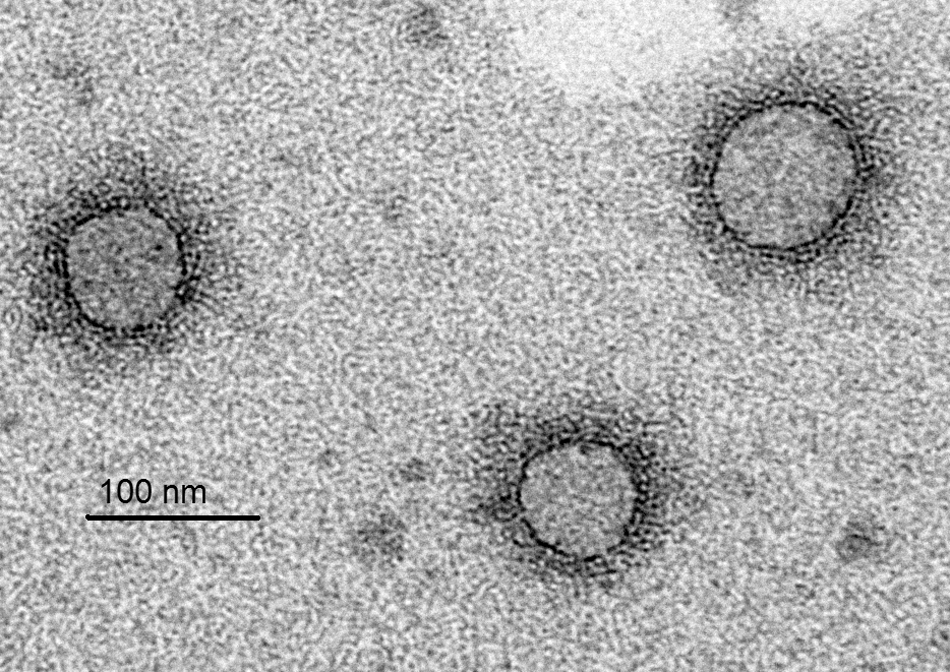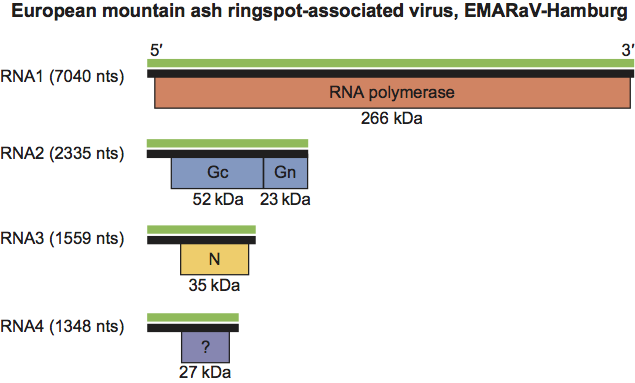Genus: Emaravirus
Chapter Version: ICTV Ninth Report; 2009 Taxonomy Release
Distinguishing features
Plant viruses with four components of negative sense ssRNA and enveloped spherical virions. They are only distantly related to other ssRNA viruses.
Virion properties
Morphology
Virions are approximately spherical and enveloped with diameter 80–100 nm (Figure 1).
Physicochemical and physical properties
Nucleic acid
Four segments of negative sense ssRNA of approximately 7.0, 2.3, 1.6 and 1.4 kb. All four RNA ends are fully conserved in a stretch of 13 nucleotides (nt). The 5′ and 3′ ends of each RNA are almost fully complementary over a sequence of between 19 and 23 nt.
Proteins
There is a nucelocapsid protein of 35.1 kDa and it is likely that a glycoprotein is integrated into the viral envelope.
Lipids
None reported.
Carbohydrates
None reported.
Genome organization and replication
Each segment of the genome encodes a single protein translated from the complementary strand. The largest segment (RNA1) encodes an RNA polymerase (266 kDa). RNA 2 encodes a glycoprotein precursor (75 kDa) that is predicted to be cleaved into products of 52 and 23 kDa. The nucleocapsid protein (35 kDa) is translated from RNA3 and an unkown protein of 27 kDa is the predicted product of the ORF on RNA4 (Figure 2).
Antigenic properties
No information available.
Biological properties
The virus is associated with, and the probable cause of, a leaf mottling and ringspot disease of European mountain ash (Sorbus aucuparia). It can be transmitted by grafting and there is some evidence that it may be naturally transmitted by mites.
Species demarcation criteria in the genus
Not applicable.
List of species in the genus Emaravirus
| European mountain ash ringspot-associated virus |
|
|
| European mountain ash ringspot-associated virus-Hamburg | RNA1: [ AY563040=NC_013105] | (EMARaV-Hamburg) |
| RNA2: [ AY563041=NC_013106] | ||
| RNA3: [ DQ831831=NC_013108] | ||
| RNA4: [ DQ831828=NC_013107] |
Species names are in italic script; names of isolates are in roman script. Sequence accession numbers [ ] and assigned abbreviations ( ) are also listed.
List of other related viruses which may be members of the genus Emaravirus but have not been approved as species
| Fig mosaic virus | RNA1: [AM941711] | (FMV) |
|
| RNA2: [FM864225] |
|
|
| RNA3: [FM992851] |
|
|
| RNA4: [FM991954] |
|
| Maize red stripe virus (High Plains virus) | RNA3: [DQ324466] | (MRSV) |
| Pigeon pea sterility mosaic virus | [AJ439561]* | (PPSMV) |
* Probably an incomplete RNA3 sequence containing the C-terminus of the nucleocapsid protein.
Similarity with other taxa
The genus Emaravirus shares some similarities with viruses belonging to the family Bunyaviridae and the floating genus Tenuivirus. The segmented genome of emaraviruses is of negative polarity. Based on a comparison of the amino acid sequences of the conserved RdRp motifs, highest similarity can be found with the plant-infecting genus Tospovirus and the orthobunyaviruses within the family Bunyaviridae. In addition, the 3′ and 5′ ends of the genomic RNAs are complementary and their conserved sequence resembles that of the genera Orthobunyavirus and Hantavirus (Bunyaviridae). However, the number of genome segments (at least four) distinguishes the genus Emaravirus from bunyaviruses and sequence analyses do not allow classification within either the family Bunyaviridae or the genus Tenuivirus.
Derivation of name
Emara: from European mountain ash ringspot-associated virus.
Further reading
Benthack et al., 2005 W. Benthack, N. Mielke, C. Büttner, H.-P. Mühlbach, Double-stranded RNA pattern and partial sequence data indicate plant virus infection associated with ringspot disease of European mountain ash (Sorbus aucuparia L.). Arch. Virol. 150 (2005) 37–52.
Elbeaino et al., 2009 T. Elbeaino, M. Digiaro, A. Alabdullah, A. De Stradis, A. Minafra, N. Mielke, M.A. Castellano, G.P. Martelli, A multipartite single-stranded negative-sense RNA virus is the putative agent of fig mosaic disease. J. Gen. Virol. 90 (2009) 1281–1288.
Elbeaino et al., 2009 T. Elbeaino, M. Digiaro, G.P. Martelli, Complete nucleotide sequence of four viral RNA segments of fig mosaic virus. Arch. Virol. 154 (2009) 1719–1727.
Mielke and Muehlbach, 2007 N. Mielke, H.-P. Muehlbach, A novel, multipartite, negative-strand RNA virus is associated with the ringspot disease of European mountain ash (Sorbus aucuparia L.). J. Gen. Virol. 88 (2007) 1337–1346.
Mielke et al., 2008 N. Mielke, M. Weber, S. Khan, H.-P. Muehlbach, Detection of European mountain ash ringspot associated virus (EMARAV) in Sorbus aucuparia L. by a specific antiserum and reverse transcription PCR. For. Path. 38 (2008) 371–380.
Mielke-Ehret et al., 2010 N. Mielke-Ehret, J. Thoma, N. Schlatermund, H.-P. Mühlbach, Detection of European mountain ash ringspot-associated virus-specific RNA and protein P3 in the pear leaf blister mite Phytoptus pyri (Eriophyidae). Arch. Virol. 155 (2010) 987–991.
Contributed by
Mühlbach, H.-P. and Mielke-Ehret, N.
Figures
Figure 1 Immunosorbent electron micrograph of virions of European mountain ash ringspot-associated virus. The bar represents 100 nm.
(Courtesy Inga Ludenberg, University of Hamburg.)

Figure 2 Genome organization of the Hamburg isolate of the species European mountain ash ringspot-associated virus. Green lines represent the virion-sense RNA and black lines the virion-complementary sense RNA, from which the proteins shown are translated. Gn and Gc are the two putative glycoproteins cleaved from the precursor molecule. N is the nucleocapsid protein.

